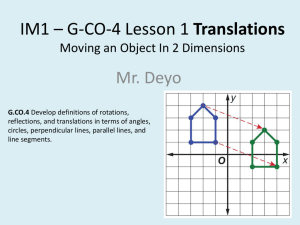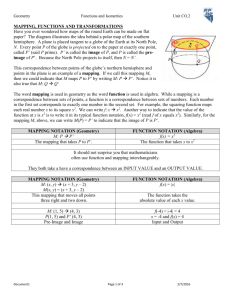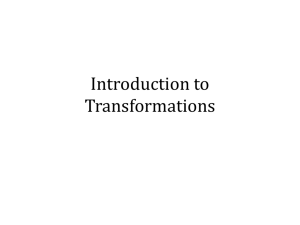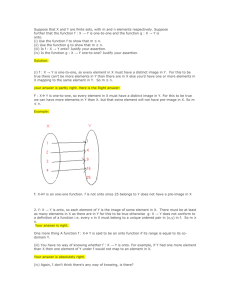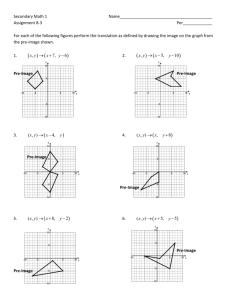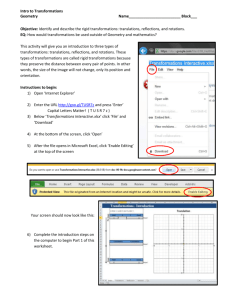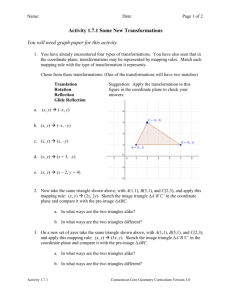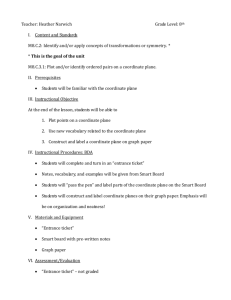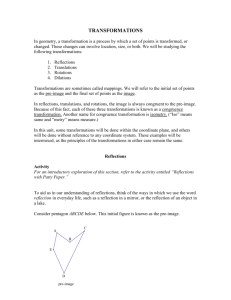Pre-Image A
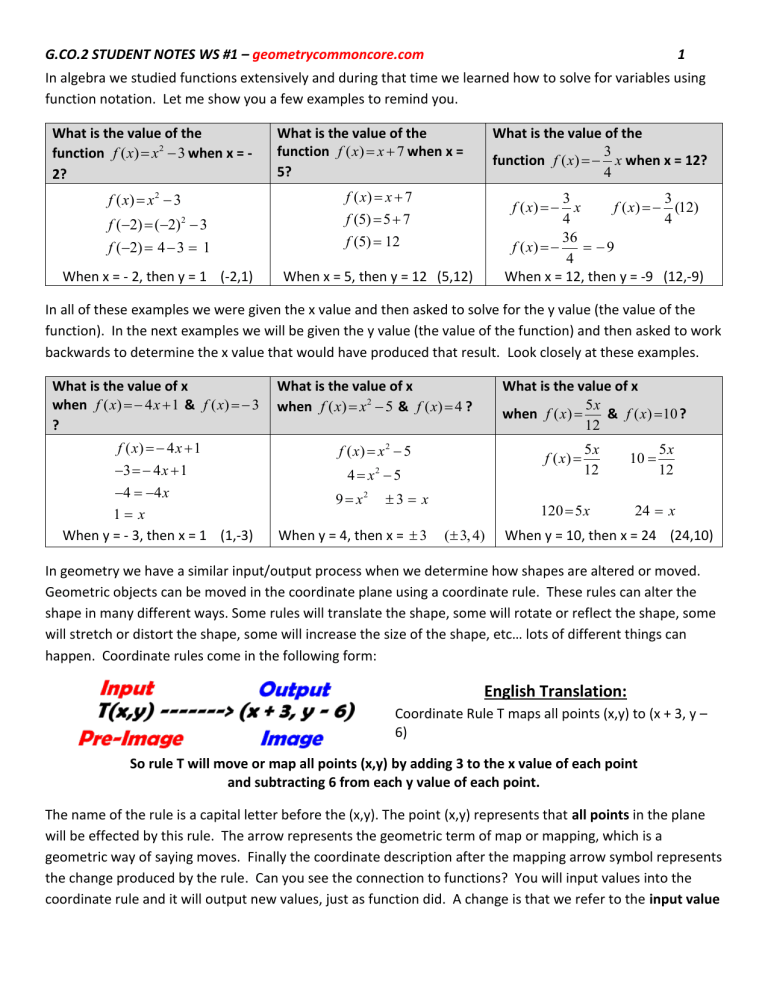
G.CO.2 STUDENT NOTES WS #1 – geometrycommoncore.com
1
In algebra we studied functions extensively and during that time we learned how to solve for variables using function notation. Let me show you a few examples to remind you.
What is the value of the function
2?
( ) x 3 when x = -
What is the value of the function
5?
( ) x 7 when x =
What is the value of the function
3
4 x when x = 12? f
( ) x 3
2
3 f ( 2) 4 3 1 f
( ) x 7 f (5)
12
3
4 x
3
(12)
4
36
4
9
When x = - 2, then y = 1 (-2,1) When x = 5, then y = 12 (5,12) When x = 12, then y = -9 (12,-9)
In all of these examples we were given the x value and then asked to solve for the y value (the value of the function). In the next examples we will be given the y value (the value of the function) and then asked to work backwards to determine the x value that would have produced that result. Look closely at these examples.
What is the value of x when ( )
4 x
1 & ( )
3
What is the value of x when ( ) x 5 & ( ) 4 ?
?
( )
4 x
1
( )
x
2
5
4 x
1
4 4 x
4
x
2
5
9
x
2 x
1
x
When y = - 3, then x = 1 (1,-3) When y = 4, then x =
3 ( 3, 4)
What is the value of x when ( )
5 x
12
5 x
12 x
& ( ) 10 ?
10
5 x
12
24
x
When y = 10, then x = 24 (24,10)
In geometry we have a similar input/output process when we determine how shapes are altered or moved.
Geometric objects can be moved in the coordinate plane using a coordinate rule. These rules can alter the shape in many different ways. Some rules will translate the shape, some will rotate or reflect the shape, some will stretch or distort the shape, some will increase the size of the shape, etc… lots of different things can happen. Coordinate rules come in the following form:
English Translation:
Coordinate Rule T maps all points (x,y) to (x + 3, y –
6)
So rule T will move or map all points (x,y) by adding 3 to the x value of each point and subtracting 6 from each y value of each point.
The name of the rule is a capital letter before the (x,y). The point (x,y) represents that all points in the plane will be effected by this rule. The arrow represents the geometric term of map or mapping, which is a geometric way of saying moves. Finally the coordinate description after the mapping arrow symbol represents the change produced by the rule. Can you see the connection to functions? You will input values into the coordinate rule and it will output new values, just as function did. A change is that we refer to the input value
G.CO.2 STUDENT NOTES WS #1 – geometrycommoncore.com
2 as the pre-image, the original location of the point, and the output value as the image, the new location of the point.
To help clarify the difference between a pre-image and an image, we use special notation. If the pre-image is point A, then its image will be A’
(said A prime). The prime notation tells us that it is an image.
Let me do a few examples to help you see the correlation between algebra and geometry.
Given coordinate rule ( , )
( x
3, y
6) , determine the image of A (-1, 5)?
( , )
( x
3, y
6)
T ( 1, 5)
T ( 1, 5)
Pre-Image A (-1,5)
Image A’ (2,-1)
Given coordinate rule ( , )
(2 ,
1) , determine the image of B (5,2)?
( , )
x y
1)
G (5, 2)
( , )
(10, 3)
Pre-Image B (5,2) Image B’ (10,3)
Both of these examples provided the pre-image (input) values and then asked you to solve for the image
(output value). We can work backwards through the process. Let us look at two where we know the image and we work backwards through the coordinate rule to solve for the pre-image.
Given coordinate rule ( , )
( x
3, y
6) , determine the pre-image of C’ (3, 2)?
( , )
( x
3, y
6) x x
3 3
0
Pre-Image C (0,8) y y
6 2
8
Image C’ (3,2)
Given coordinate rule ( , )
(2 ,
1) , determine the pre-image of D’ (-4, 11)?
( , )
x y
1)
2 x x
4
2 y y
1 11
10
Pre-Image D (-2,10) Image D’ (-4,11)
Sometimes function are described as input/output machines. The example to the right shows the input/output machine of
( )
5 . When we input x = -1, the function machine produces the output of 4.
I will use function machine above to determine the missing output or input values.
Input = 3
( )
5 f (3) 3 5 f (3)
8
Output = 8
Output = 11
( ) x
11
6
x
5
5
Input = 6
Input = 0
( )
5 f (0) 0 5 f (0)
5
Output = 5

